英语修辞学例子
英语专业高级英语修辞介绍及例句
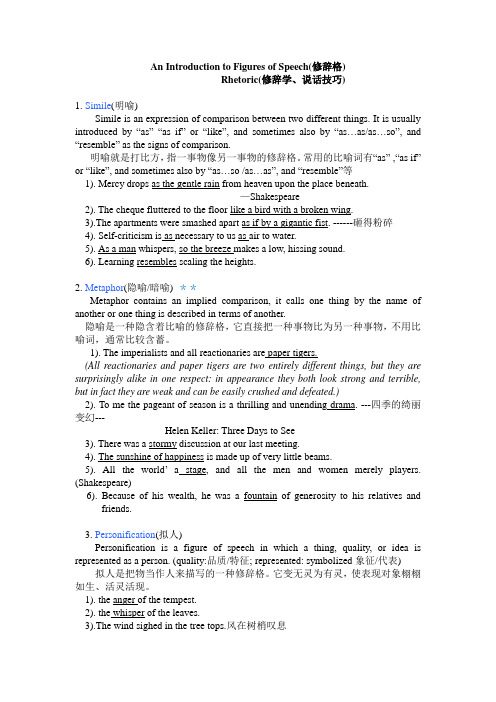
An Introduction to Figures of Speech(修辞格)Rhetoric(修辞学、说话技巧)1.Simile(明喻)Simile is an expression of comparison between two different things. It is usually introduced by “as”“as if”or “like”, and sometimes also by “as…as/as…so”, and “resemble” as the signs of comparison.明喻就是打比方,指一事物像另一事物的修辞格。
常用的比喻词有“as” ,“as if”or “like”, and sometimes also by “as…so /as…as”, and “resemble”等1). Mercy drops as the gentle rain from heaven upon the place beneath. —Shakespeare2). Thecheque fluttered to the floor like a bird with a broken wing.3).The apartments were smashed apart as if by a gigantic fist. ------砸得粉碎4). Self-criticism is as necessary to us as air to water.5). As a man whispers, so the breeze makes a low, hissing sound.6). Learning resembles scaling the heights.2. Metaphor(隐喻/暗喻)**Metaphor contains an implied comparison, it calls one thing by the name of another or one thing is described in terms of another.隐喻是一种隐含着比喻的修辞格,它直接把一种事物比为另一种事物,不用比喻词,通常比较含蓄。
英语学习:除了比喻拟人,常见的英语修辞你都会吗?

英语学习:除了比喻拟人,常见的英语修辞你都会吗?英语学习:除了比喻拟人,常见的英语修辞你都会吗?1.simile明喻A simile is a figure of speech in which two fundamentally unlike things are explicitly compared, usually in a phrase introduced by like or as.明喻是常用as或like等词将两种不同事物通过比较而连接起来的一种修辞手法。
让我们看几个例子:Good coffee is like friendship: rich and warm and strong.好的咖啡如同友谊,丰厚,温暖,热烈。
Life is rather like opening a tin of sardines. We're all of us looking for the key.人生就像一罐沙丁鱼,我们大家都在找开启的起子。
He was like a cock who thought the sun had risen from him to crow. 他这人就像一只骄傲的公鸡,以为太阳升起是为了它的啼叫。
2.metaphor暗喻A metaphor is a trope or figure of speech in which an implied comparison is made between two unlike things that actually have something in common.暗喻是将两种有共同点的不同事物进行隐晦比较的修辞手法。
明喻与暗喻的不同点就在于是否有出现like或者as(像)这一类比喻词,下面这几个句子都是暗喻:Humor is the shock absorber of life; it helps us take action.幽默是生活的减震器,它可以鼓舞人们付诸于行动。
英语修辞学中20种常见修辞格名称双语释义及举例
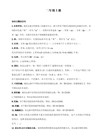
What does that lawyer do after he dies?——Lie still. 那个律师死后干什么?──躺着仍说鬼话。(注:lie躺, 撒谎;still安静地, 仍然)
E. oxymoron; zeugma ; contrast
Oxymoron(矛盾修辞法)与汉语中的反映辞格类似,都是将相互矛盾的概念和判断巧妙地联系在一起,以便相互映衬,突出事物的特点,表达复杂的思想感情和意味深长的哲理。矛盾修辞手法在英语中常见,但在汉语中很少见。如:sweet sorrow 忧喜参半 (不是甜蜜的悲伤); proud humility 不卑不亢(不是骄傲的谦卑)
这个项目从一开始就是一个摆脱不了的经济难题。(Albatross是英国诗人柯勒律治的《古舟子咏》中的信天翁,它被忘恩负义的水手杀死后,全船陷入灾难中。)
B. metonymy; transferred epithet Metonymy、synecdoche和_1antonomasia都是不直接说出事物的本来名称,而换用另一个名称或另一个说法。它们大体上相当于汉语的借代(分为旁借和对代两类)。如Crown(王冠)可喻指君主、王权、王国政府等;doll(玩具)可喻指姑娘、宝贝等。再如:
as thick as thieves亲密无间(不是"像贼一样厚")
as old as the hills古老 (不是"像山一样老")
The ship plows the sea. 船在乘风破浪地前进。(不是"船在犁海")
Allusion与汉语的暗引相近似。其特点是不注明来源和出处,一般多引用人们熟知的关键词或词组,将其融合编织在作者的话语中。引用的东西包括典故、谚语、成语、格言和俗语等。英语引用最多的是源出《圣经》故事以及希腊、罗马神话、《伊索寓言》和那些渊源流长的谚语、格言等。例如:
英语修辞手法的例子
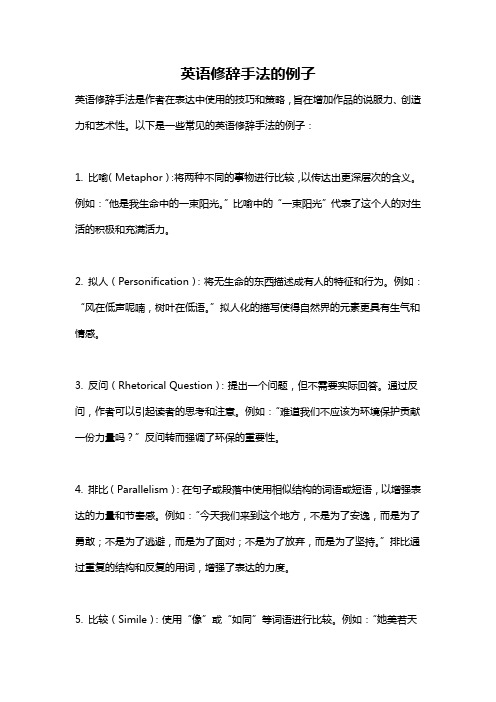
英语修辞手法的例子英语修辞手法是作者在表达中使用的技巧和策略,旨在增加作品的说服力、创造力和艺术性。
以下是一些常见的英语修辞手法的例子:1. 比喻(Metaphor):将两种不同的事物进行比较,以传达出更深层次的含义。
例如:“他是我生命中的一束阳光。
”比喻中的“一束阳光”代表了这个人的对生活的积极和充满活力。
2. 拟人(Personification):将无生命的东西描述成有人的特征和行为。
例如:“风在低声呢喃,树叶在低语。
”拟人化的描写使得自然界的元素更具有生气和情感。
3. 反问(Rhetorical Question):提出一个问题,但不需要实际回答。
通过反问,作者可以引起读者的思考和注意。
例如:“难道我们不应该为环境保护贡献一份力量吗?”反问转而强调了环保的重要性。
4. 排比(Parallelism):在句子或段落中使用相似结构的词语或短语,以增强表达的力量和节奏感。
例如:“今天我们来到这个地方,不是为了安逸,而是为了勇敢;不是为了逃避,而是为了面对;不是为了放弃,而是为了坚持。
”排比通过重复的结构和反复的用词,增强了表达的力度。
5. 比较(Simile):使用“像”或“如同”等词语进行比较。
例如:“她美若天使,皮肤如同雪一般洁白。
”比较使得形容女性的美丽更为生动形象。
6. 倍数修饰(Hyperbole):通过夸张的表达来增强语气。
例如:“这个礼物是我有生以来收到的最棒的礼物!”通过夸大表达,强调了礼物的重要性和特别之处。
7. 对比(Contrast):通过对两个事物或概念进行对比,突显它们之间的差异和重要性。
例如:“黑暗中的孤独和明亮中的欢乐形成了鲜明的对比。
”对比使得表达更加鲜明,更能引起读者的共鸣。
8. 双关(Pun):使用同音异义词创造幽默效果。
例如:“时间如流沙,一去不复返。
”这里的“流沙”既有实际的流沙之意,也指的是时间的流逝,形成了幽默效果。
9. 借代(Metonymy):用代表整体的部分代替整体来表达意思。
常见的小学生英语作文修辞

常见的小学生英语作文修辞这篇文章里,我们就来谈一谈英文中常见的修辞手法。
1.simile明喻A simile is a figure of speech in which two fundamentally unlike things are explicitly compared, usually in a phrase introduced by like or as.明喻是常用as或like等词将两种不同事物通过比较而连接起来的一种修辞手法。
让我们看几个例子:Good coffee is like friendship: rich and warm and strong.好的咖啡如同友谊,丰厚,温暖,热烈。
Life is rather like opening a tin of sardines. We're all of us looking for the key.人生就像一罐沙丁鱼,我们大家都在找开启的起子。
He was like a cock who thought the sun had risen from him to crow.他这人就像一只骄傲的公鸡,以为太阳升起是为了它的啼叫。
2.metaphor暗喻A metaphor is a trope or figure of speech in which an implied comparison is made between two unlike things that actually have something in common.暗喻是将两种有共同点的不同事物进行隐晦比较的修辞手法。
明喻与暗喻的不同点就在于是否有出现like或者as(像)这一类比喻词,下面这几个句子都是暗喻:Humor is the shock absorber of life; it helps us take action.幽默是生活的减震器,它可以鼓舞人们付诸于行动。
英语修辞手法的例子

英语修辞手法的例子修辞手法是指通过巧妙运用语言的方式,增强表达的艺术效果。
在英语写作中,修辞手法是一种强大的工具,可以使文本更具吸引力、感染力和说服力。
以下是一些常用的英语修辞手法,并且配上了例子,以便更好地理解它们的运用。
1. 比喻(Metaphor):比喻是通过把一个事物比作另一个事物来传达意义和形象化情感的一种修辞手法。
比喻的目的是创造视觉和情感上的联想,使读者更好地理解和感受文本的意义。
例子:- Life is a journey. (人生如旅程)- His words were music to my ears. (他的话音如音乐般妙听)2. 拟人(Personification):拟人是指将无生命的事物赋予人类的特质、行为或意愿,以此增加描写的生动感和表达的深度。
例子:- The wind whispered through the trees. (风在树叶间低语)- The flowers danced in the breeze. (花在微风中跳舞)3. 对比(Contrast):对比通过将两个相反或不同的事物进行对比,以突出它们之间的差异和相互作用,增强文章的对比效果。
例子:- Love is both a rose and a thorn. (爱情既是玫瑰又是刺)- The sunset was a beautiful mix of vibrant colors against the dark horizon. (夕阳把鲜艳的色彩与黑暗的地平线形成了美丽的对比)4. 反复重复(Repetition):反复重复是通过在文章中反复使用相同的词语、短语或句子,以增加其强调和记忆力,使之更加令人难以忘怀。
例子:- Alone, alone, all, all alone, / Alone on a wide wide sea! (《古船上的人》里的反复重复)- I know, I know, I know. (我知道,我知道,我知道)5. 比较(Simile):比较是通过使用"like"或"as"来进行明确的比较,以便更好地理解和描绘事物的特点和属性。
英语中所有26种修辞手法的全部解释和例句

英语修辞手法总结Figures of speech (修辞)are ways of making our language figurative. When we use words in other than their ordinary or literal sense to lend force to an idea, to heighten effect, orto create suggestive imagery, we are said to be speaking or writing figuratively. Now we are going to talk about some common forms of figures of speech.1) Simile:(明喻)It is a figure of speech which makes a comparison between two unlike elements having at least one quality or characteristic (特性)in common. To make the comparison, words like as, as...as, as if and like are used to transfer the quality we associate with one to the other. For example, As cold waters to a thirsty soul, so is good news from a far country.2) Metaphor:(暗喻)It is like a simile, also makes a comparison between two unlike elements, but unlike a simile, this comparison is implied rather than stated. For example, the worldis a stage.3) Analogy: (类比)It is also a form of comparison, but unlike simile or metaphor which usually uses comparison on one point of resemblance, analogy draws a parallel between two unlike things that have several common qualities or points of resemblance.4) Personification: (拟人)It gives human form of feelings to animals, or life and personal attributes(赋予) to inanimate(无生命的) objects, or to ideas and abstractions(抽象). For example, the wind whistled through the trees.5) Hyperbole: (夸张) It is the deliberate use of overstatement or exaggeration to achieve emphasis. For instance, he almost died laughing.6) Understatement: (含蓄陈述) It is the opposite of hyperbole, or overstatement. Itachieves its effect of emphasizing a fact by deliberately(故意地) understating it,impressing the listener or the reader more by what is merely implied or left unsaid than by bare statement. For instance, It is no laughing matter.7) Euphemism: (委婉) It is the substitution of an agreeable or inoffensive(无冒犯) expression for one that may offend or suggest something unpleasant. For instance, we refer to "die" as " pass away".8) Metonymy (转喻)It is a figure of speech that has to do with the substitution of the mane of one thing for that of another. For instance, the pen (words) is mightier than the sword (forces).9) Synecdoche (提喻) It is involves the substitution of the part for the whole, or thewhole for the part. For instance, they say there's bread and work for all. She was dressedin silks.10) Antonomasia (换喻)It has also to do with substitution. It is not often mentioned now, though it is still in frequent use. For example, Solomon for a wise man. Daniel for a wise and fair judge. Judas for a traitor.11) Pun: (双关语) It is a play on words, or rather a play on the form and meaning of words. For instance, a cannon-ball took off his legs, so he laid down his arms. (Here "arms" has two meanings: a person's body; weapons carried by a soldier.)12) Syllepsis: (一语双叙) It has two connotations.In the first case, it is a figure by which a word, or a particular form or inflection of a word, refers to two or more words in the same sentence, while properly applying to or agreeing with only on of them in grammar or syntax(句法). For example, He addressed you and me, and desired us to follow him. (Here us is used to refer to you and me.)In the second case, it a word may refer to two or more words in the same sentence. For example, while he was fighting , and losing limb and mind, and dying, others stayed behind to pursue education and career. (Here to losing one's limbs in literal; to lose one's mindis figurative, and means to go mad.)13) Zeugma: (轭式搭配) It is a single word which is made to modify or to govern two or more words in the same sentence, wither properly applying in sense to only one of them, orapplying to them in different senses. For example, The sun shall not burn you by day, nor the moon by night. (Here noon is not strong enough to burn)14) Irony: (反语) It is a figure of speech that achieves emphasis by saying the opposite of what is meant, the intended meaning of the words being the opposite of their usual sense. For instance, we are lucky, what you said makes me feel real good.15) Innuendo: (暗讽) It is a mild form of irony, hinting in a rather roundabout (曲折)way at something disparaging(不一致) or uncomplimentary(不赞美) to the person or subject mentioned. For example, the weatherman said it would be worm. He must take his readings in a bathroom.16) Sarcasm: (讽刺) It Sarcasm is a strong form of irony. It attacks in a taunting and bitter manner, and its aim is to disparage, ridicule and wound the feelings of the subject attacked. For example, laws are like cobwebs, which may catch small flies, but let wasps break through.17) Paradox: (似非而是的隽语) It is a figure of speech consisting of a statement or proposition which on the face of it seems self-contradictory, absurd or contrary to established fact or practice, but which on further thinking and study may prove to be true, well-founded, and even to contain a succinct point. For example more haste, less speed.18) Oxymoron: (矛盾修饰) It is a compressed paradox, formed by the conjoining(结合) of two contrasting, contradictory or incongruous(不协调) terms as in bitter-sweet memories, orderly chaos(混乱) and proud humility(侮辱).19) Antithesis: (对照) It is the deliberate arrangement of contrasting words or ideas in balanced structural forms to achieve emphasis. For example, speech is silver; silence is golden.20) Epigram: (警句) It states a simple truth pithily(有利地) and pungently(强烈地). It is usually terse and arouses interest and surprise by its deep insight into certain aspects of human behavior or feeling. For instance, Few, save the poor, feel for the poor.21) Climax: (渐进) It is derived from the Greek word for "ladder" and implies the progression of thought at a uniform or almost uniform rate of significance or intensity,like the steps of a ladder ascending evenly. For example, I came, I saw, I conquered.22) Anti-climax or bathos: (突降)It is the opposite of Climax. It involves stating one's thoughts in a descending order of significance or intensity, from strong to weak, from weighty to light or frivolous. For instance, But thousands die, without or this or that, die, and endow(赋予) a college, or a cat.23) Apostrophe: (顿呼) In this figure of speech, a thing, place, idea or person (dead or absent) is addressed as if present, listening and understanding what is being said. For instance, England! awake! awake! awake!24) Transferred Epithet: (转类形容词) It is a figure of speech where an epithet (anadjective or descriptive phrase) is transferred from the noun it should rightly modify(修饰) to another to which it does not really apply or belong. For instance, I spent sleeplessnights on my project.25) Alliteration: (头韵) It has to do with the sound rather than the sense of words for effect. It is a device that repeats the same sound at frequent intervals(间隔) and since the sound repeated is usually the initial consonant sound, it is also called "front rhyme". For instance, the fair breeze blew, the white foam flew, the furrow followed free.26) Onomatopoeia: (拟声) It is a device that uses words which imitate the sounds made by an object (animate or inanimate), or which are associated with or suggestive(提示的) of some action or movementExplanation version1一、什么是修辞格修辞格(figures of speech)是提高语言表达效果的语言艺术。
40种英文修辞 中文版
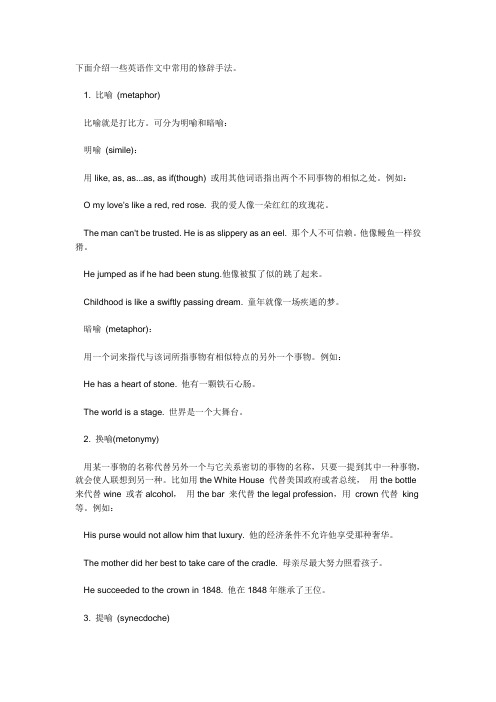
下面介绍一些英语作文中常用的修辞手法。
1. 比喻(metaphor)比喻就是打比方。
可分为明喻和暗喻:明喻(simile):用like, as, as...as, as if(though) 或用其他词语指出两个不同事物的相似之处。
例如:O my love's like a red, red rose. 我的爱人像一朵红红的玫瑰花。
The man can't be trusted. He is as slippery as an eel. 那个人不可信赖。
他像鳗鱼一样狡猾。
He jumped as if he had been stung.他像被蜇了似的跳了起来。
Childhood is like a swiftly passing dream. 童年就像一场疾逝的梦。
暗喻(metaphor):用一个词来指代与该词所指事物有相似特点的另外一个事物。
例如:He has a heart of stone. 他有一颗铁石心肠。
The world is a stage. 世界是一个大舞台。
2. 换喻(metonymy)用某一事物的名称代替另外一个与它关系密切的事物的名称,只要一提到其中一种事物,就会使人联想到另一种。
比如用the White House 代替美国政府或者总统,用the bottle 来代替wine 或者alcohol,用the bar 来代替the legal profession,用crown代替king 等。
例如:His purse would not allow him that luxury. 他的经济条件不允许他享受那种奢华。
The mother did her best to take care of the cradle. 母亲尽最大努力照看孩子。
He succeeded to the crown in 1848. 他在1848年继承了王位。
3. 提喻(synecdoche)指用部分代表整体或者用整体代表部分,以特殊代表一般或者用一般代表特殊。
英语修辞学(Rhetoric)
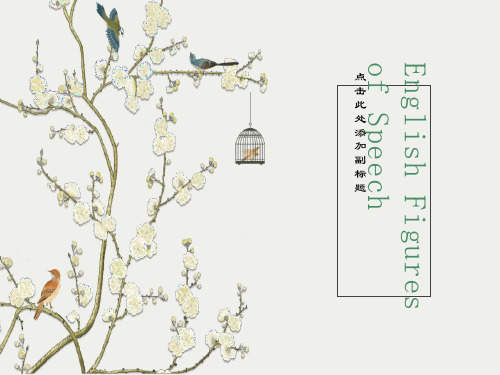
Syllepsis
Syllepsis是指用一个词(如动词、形容词、介词等)同时与两个或更多的词相搭配,在越一个词搭配时用一种词义,而在与另一个词搭配时则用另一种词义,这种搭配在句法规则和语义上都是正确的,并产生不同的字面意义和比喻意义。
He lost the game and his temper. 他输了这一局,大发脾气。
半谐音也可称“无韵”,是指一组词、一句话或一行诗中同一元音重复出现,它具有音乐的节奏感,可增强语言的表现力。例如:
It’s fair and square affair from the beginning to the end. 这件事自始至终都是光明正大的。
All roads lead to Rome. 条条大路通罗马。
Pun
双关(pun) 就是用发音相似的词来表达特殊意义的修辞手法,它非常能够体现使用者的睿智机敏、幽默俏皮,造成印象隽永的效果。它的使用场合亦庄亦谐,既常见于故事、笑话、谜语、儿歌等,又可用于正式场合,表达严肃的思想和深邃的感情。 — Why is an empty parse always the same? — Because there is never any change in it.(change既表示“零钱”,又表示“变化”。“空钱包”里边没“零钱”当然就永远瘪着,毫无“变化”了。)
2。主体和喻体一般指两个不同的事物。
本体和喻体通常一个抽象一个具体,一个熟悉一个陌生
Simile(明喻)
希腊语Metapherein (transfer )转换
无需借助比喻词,直接将甲事物当作乙事物来描写。也称隐喻,是依据比喻和被比喻两种不同事物的相似或相关关系而构成的修辞格。 例如:
英语修辞学(Rhetoric) (1)

English Figures of Speech
英语修辞的一般规律与特点 General principles and features of English rhetoric
1. 关系词丰富,介词、连词、关系代词和关系副词 关系词丰富,介词、连词、 等的充分利用,使英语成为一种更为形式的语言, 等的充分利用,使英语成为一种更为形式的语言, 即以形合为主的语言。而汉语是以意合为主的语言。 即以形合为主的语言。而汉语是以意合为主的语言。
4. 英语被动句用得多,汉语主动句用得多。这更说明了英语 英语被动句用得多,汉语主动句用得多。 物称倾向” 的“物称倾向”。 An illustration is furnished by an editorial in the Washington Post (January 17, 1962). 华盛顿邮报》 《华盛顿邮报》(1962年1月17日)的一篇社论提供了一个 年 月 日 例子。 例子。 It has been known for a long time that there is a first relationship between the heart and liver. 长期以来,大家知道心脏和肝脏的关系是最重要的。 长期以来,大家知道心脏和肝脏的关系是最重要的。 The challenge from the Third World has always been foreseen by our shipping companies. 我国的海运公司总能预见来自第三世界的挑战。 我国的海运公司总能预见来自第三世界的挑战。
The three uses of similes:
Descriptive描述型明喻; Illuminative启示型明喻 ; Illustrative说明型明喻;
修辞格英语的例子

修辞格(Rhetorical devices)是用于增强语言表达效果的技巧和方法。
以下是一些常见的修辞格英语例子:1. 比喻(Metaphor):通过将一个事物比作另一个事物来形成形象生动的表达。
例如:- "He is a shining star in our company."(他是我们公司的一颗闪耀的明星。
)2. 明喻(Simile):通过使用“像”、“如”等词将两个事物进行比较。
例如:- "She sings like a professional."(她唱歌像个专业人士。
)3. 拟人(Personification):将非人类事物赋予人类特征。
例如:- "The wind whispered through the trees."(风在树林中低语。
)4. 排比(Parallelism):通过重复类似的句子结构或短语来增强表达的力度。
例如:- "I came, I saw, I conquered."(我来,我见,我征服。
)5. 反问(Rhetorical question):提出一个问题,实际上并不期待回答,而是用来强调某个观点。
例如:- "Can we ever stop learning?"(我们能否停止学习?)6. 夸张(Hyperbole):通过对某个事物进行过度描述来强调其特点。
例如:- "I have a million things to do."(我有成千上万的事情要做。
)7. 反讽(Irony):通过说与自己真正意图相反的话来表达讽刺意味。
例如:- "I'm so happy to be stuck in traffic."(我太高兴堵在交通中了。
)8. 比拟(Analogy):通过比较相似之处来说明某个概念。
例如:-"The relationship between a teacher and a student is like a garden: the teacher waters the seeds, and the student grows."(教师和学生之间的关系就像花园:教师灌溉种子,学生成长。
英语中19种修辞手法和例句(推荐阅读)

英语中19种修辞手法和例句(推荐阅读)第一篇:英语中19种修辞手法和例句1.Simile 明喻明喻是将具有共性的不同事物作对比.这种共性存在于人们的心里,而不是事物的自然属性.标志词常用like, as, seem, as if, as though, similar to, such as等.例如:1>.He was like a cock who thought the sun had risen to hear him crow.2>.I wandered lonely as a cloud.3>.Einstein only had a blanket on, as if he had just walked out of a fairy tale.2.Metaphor 隐喻,暗喻隐喻是简缩了的明喻,是将某一事物的名称用于另一事物,通过比较形成.例如:1>.Hope is a good breakfast, but it is a bad supper.2>.Some books are to be tasted, others swallowed, and some few to be chewed and digested.3.Metonymy 借喻,转喻借喻不直接说出所要说的事物,而使用另一个与之相关的事物名称.I.以容器代替内容,例如:1>.The kettle boils.水开了.2>.The room sat silent.全屋人安静地坐着.II.以资料.工具代替事物的名称,例如:Lend me your ears, please.请听我说.III.以作者代替作品,例如:a complete Shakespeare 莎士比亚全集VI.以具体事物代替抽象概念,例如:I had the muscle, and they made money out of it.我有力气,他们就用我的力气赚钱.4.Synecdoche 提喻提喻用部分代替全体,或用全体代替部分,或特殊代替一般.例如:1>.There are about 100 hands working in his factory.(部分代整体)他的厂里约有100名工人.2>.He is the Newton of this century.(特殊代一般)他是本世纪的牛顿.3>.The fox goes very well with your cap.(整体代部分)这狐皮围脖与你的帽子很相配.5.Synaesthesia 通感,联觉,移觉这种修辞法是以视.听.触.嗅.味等感觉直接描写事物.通感就是把不同感官的感觉沟通起来,借联想引起感觉转移,“以感觉写感觉”。
大学 英语修辞整理及例子
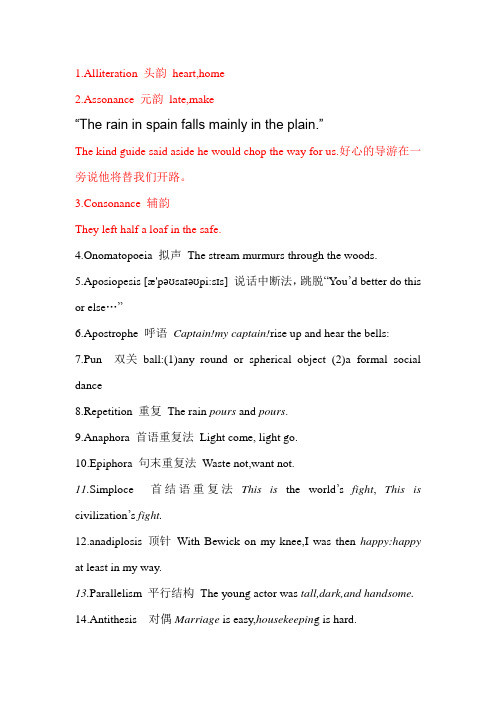
1.Alliteration 头韵heart,home2.Assonance 元韵late,make“The rain in spain falls mainly in the plain.”The kind guide said aside he would chop the way for us.好心的导游在一旁说他将替我们开路。
3.Consonance 辅韵They left half a loaf in the safe.4.Onomatopoeia 拟声The stream murmurs through the woods.5.Aposiopesis [æ'pəʊsaɪəʊpi:sɪs] 说话中断法,跳脱“You’d better do this or else…”6.Apostrophe 呼语Captain!my captain!rise up and hear the bells:7.Pun 双关ball:(1)any round or spherical object (2)a formal social dance8.Repetition 重复The rain pours and pours.9.Anaphora 首语重复法Light come, light go.10.Epiphora 句末重复法Waste not,want not.11.Simploce首结语重复法This is the world’s fight, This is civilization’s fight.12.anadiplosis 顶针With Bewick on my knee,I was then happy:happy at least in my way.13.Parallelism 平行结构The young actor was tall,dark,and handsome.14.Antithesis 对偶Marriage is easy,housekeepin g is hard.15.Climax 层进法We want peace,we want freedom,we want a better life.16.Anticlimax 突降法Where shall I find hope, happiness ,friends, cigarettes?17.Syllepsis 一语双叙He lost his coat and his temper.18.Zeugma 轭式修辞法We ate a bun and a glass of milk.19.Chiasmus 回文One should eat to live,not live to eat.20.Asyndeton 连词省略法Nothing is insider them, they were sealed up before the creation of pestilence.21.Polysyndeton 连词叠用法I am a soul,or a body, a mind.22.Rhetorical question 反问Isn’t it the best choice?23.Simile 明喻Time flies like an arrow.24.Metaphor 暗喻You are my sunshine.25.Metonymy 借喻He has a good ear for music.26.Synecdoche 提喻He paid the workers $5 per head.27.Antonomasia换称He is modern Hitler---a tyrant.Jack is Michael Jordan on our basketball team.28.Personification 拟人The bird is singing joyfully.29.Parody 仿拟I had no outlook,but an uplook rather.30.Synesthesia 通感The music breathing from her face.31.Transferred epithet 移情a sleepless bed32.. understatement 轻描淡写,低调陈述1.AUTHOR &WORKS1>William Faulkner is the author of ______.A. Far From the Madding CrowdB. Sound and FuryC. For Whom the Bell TollsD. Scarlet LetterKey B2>The Old Man and the Sea is one of the great works by _____.A. Jack LondonB. Charles DickensC. Samuel ColeridgeD. Ernest HemingwayKey: D3>James Joyce is the author of all the following novels EXCEPT ______.A. DublinersB. A Portrait of the Artist as a Young ManC. Jude the ObscureD. UlyssesKey: C4>Which of the following is NOT a poem by Emily Dickinson?A. This is my letter to the world.B. / heard a fly buzz —when I died.C. This is just to say.D. Because I could not stop for death. Key: C (William Carlos Williams)5>Francis Bacon' s _____ is a great essay on education.A. The Advancement of LearningB. The Importance of Being EarnestC. The New AtlanticD. The Learned Reading upon the Statute of UsesKey: A6>William Makepeace Thackeray' s most famous work is ______.A. The School for ScandalB. Past and PresentC. Major BarbaraD. Vanity FairKey: D7>Which of the following poems is NOT written by George Gordon Byron?A. She Walks in Beauty.B. The Solitary Reaper.C. When We Two Parted.D. Childe Harold' s Pilgrimage.Key: B8> William Golding' s first and most well-known novel is ______.A. Coral IslandB. Lord of the FliesC. Treasure IslandD. The Brass ButterflyKey: B9> Moby Dick is the most important work by ______.A. Jack LondonB. Herman MelvilleC. Sinclair LewisD. Ralph EllisonKey: B10>Stephen Crane is famous for ______.A. An American TragedyB. The AmbassadorsC. Main StreetD. The Red Badge of Courage Key: D11>Robert Frost is a famous _____.A. novelistB. playwrightC. poetD. literary criticKey: C12>Eugene 0' Neil is an American ______.A. novelistB. playwrightC. poetD. essayist KEY:B13>_____ is considered to be the best-known English dramatist since Shakespeare, and his representative works are plays inspired by social criticism.A. Richard SheridanB. Oliver GoldsmithC. Oscar WildeD. Bernard ShawKEY:D14>Who is the only woman writer that has won both Pulitzer Prize and Nobel Prize?A. Pearl Buck.B. Virginia Woolf.C. Tony Morrison.D. Katharine Mansfield.KEY: A15> ______ is NOT among the postwar poets in modem American literature.A. Robert LowellB. Gary SynderC. Alien GinsbergD. e. e. cummingsKEY: D16>Shylock is a character in ______.A. The Merchant of VeniceB. The Twelfth NightC. The Winter's TaleD. MacbethKEY: A17>This line "If Winter comes, can Spring be far behind?' is quoted from ______.A. Don Juan.B. Kubla KhanC. To AutumnD. Ode to the West Wind KEY: D18>The sentence "Shall I compare thee to a summer' s day" is quoted from Shakespeare' s ______.A. comediesB. tragediesC. historiesD. sonnetsKEY : D19>"Beauty is truth, truth beauty" is an epigrammatic line by ______.A. John KeatsB. William BlakeC. William WordsworthD. Percy Bysshe ShelleyKEY: A19>"Beauty is truth, truth beauty" is an epigrammatic line by ______.A. John KeatsB. William BlakeC. William WordsworthD. Percy Bysshe Shelley KEY: A20>Tess is a character created by ______.A. D. H. LawrenceB. James JoyceC. Thomas HardyD. Dylan Thomas Key: C21>As a literary figure, Heathcliff appears in ______.A. Jane EyreB. Oliver TwistC. Wuthering HeightsD. Middlemarch Key: C22>Emily Grierson is a literary figure created by ______.A. Willa GatherB. Doris LessingC. William FaulknerD. Nathaniel Hawthorn Key: C23> Mr. Micawber in David Copperfield and Sam Well in Pickwick Papers are perhaps the best ______ characters created by Charles Dickens.A. comicB. tragicC. roundD. sophisticated Key: A24> Mr. Darcy is a character in ______.A. Tess of the D' UrhervillesB. Pride and PrejudiceC. Happy PrinceD. The Mill on the Floss Key: B25> The image of the famous "henpecked husband" is created by______.A. Washington IrvingB. Fennimore CooperC. Edith WhartonD. William Dean Howells Key: A26> ______ is a popular literary form in the medieval period.A. RomanceB. NovelC. SonnetD. Drama Key: A27> ______ was the most important person of the transcendental club.A. HawthornB. WhitmanC. EmersonD. Thoreau Key: C28> The literary spokesman of the Jazz is often thought to be _____.A. O'NeilB. PoundC. Robert FrostD. Scott Fitzgerald Key: D29>Together with Lawrence and Joyce, ______ is considered one of the three giants of the modern English novel and a master of English prose.A. Henry JamesB. Joseph ConradC. E. M. ForsterD. Aldous Huxley Key: B30>_____,the author of The Interpretation of Dreams has great impact on literary creation and criticism.A. Carl JungB. Jean-Paul SartreC. Friedrich Wilhelm NietzscheD. Sigmund Freud Key: D31> Which of the following is NOT a typical feature of Modernism?A.To elevate the individual and inner being over the social being.B. To put the stress on traditional values.C.To portray the distorted and alienated relationships between man and his environment.D.To advocate a conscious break with the past. Key: B32>Whitman's poems are characterized by all the following features EXCEPT _____.A. a strict poetic formB. a simple and conversational languageC. a free and natural rhythmic patternD. an easy flow of feelings Key: A33> Who initiated the name of the Lost Generation?A. Hemingway.B. Fitzgerald.C. Gertrude Stein.D. William Faulkner. Key: C34> The high tide of Romanticism in American literature occurred around ______.A. 1820B. 1850C. 1880D. 1920 Key: A35> The success of Jane Eyre is partly due to its introduction to the English novel the first _____ heroine.A. explorerB. peasantC. workerD. governess Key: D36> _____ is the representative work of the Beat Generation.A. The Great GatsbyB. On the RoadC. Look Back in AngerD. The Sun Also Rises Key: B37>The most significant idea of the Renaissance is ______.A. humanismB. realismC. naturalismD. skepticism Key: A38>The title of Thackeray's "Vanity Fair" is taken from __A. The Holy BibleB. The Faerie QueenC.The Pilgrim's ProgressD. Paradise Lost Key: C39>Who is considered the father of American poetry?A. Philip Freneau.B. William Cullen Bryant.C. Henry Wadsworth Longfellow.D. Henry David Thoreau.Key: A ( The Wild Honey Suckle)40>Iceberg Theory is a writing principle proposed and closely followedby_______.A. Jack LondonB. Sinclair LewisC. William FaulknerD. Earnest Hemingway Key: D41> _____ is featured by black humor.A. CaricatureB. Catch-22C. The Catcher in the RyeD. Death of a Salesman Key: B42>______ has won the Pulitzer Prize four times and Nobel Prize.A. Ernest HemingwayB. John SteinbeckC. Eugene 0' NeilD. William Faulkner Key: C43> ______ is known as "the poet' s poet".A. ShakespeareB. MarloweC. SpenserD. Donne Key: C44> Robert Burns is a poet from ______.A. EnglandB. New EnglandC. IrelandD. Scotland Key: D45>Generally, the Renaissance refers to the period between _____ and _____ centuries.A. 14th/mid-17thB. 14th/mid-18thC. 16th/mid-18thD. 16th/mid-17th Key: A46>O Captain! My Captain! was written in memory of _____.A. Walt WhitmanB. Benjamin FranklinC. Abraham LincolnD. Martin Luther King Key: C47>The first book of the Old Testament is called ______.A. ExodusB. NumbersC. LeviticusD. Genesis Key: D48>William Blake' s The Tiger is collected in ______.A. Songs of InnocenceB. Songs of ExperienceC. Marriage of Heaven and HellD. Poetical Sketches Key: B49>Who is the father of English poetry?A. Shakespeare.B. Edmund Spencer.C. John Milton.D. Geoffrey Chaucer. Key: D50>The 1954 Nobel Prize for literature was awarded to _____ for his "mastery of the art of modem narration".A.William FaulknerB. John SteinbeckC. Saul BellowD. Ernest Hemingway Key: D51>It is generally regarded that Keats’s most important and mature poems are in the form of___.A. odeB. elegyC. epicD. sonnet Key: A52> 0. Henry earned his fame mainly for his _____.A. novelsB. poemsC. short storiesD. dramas Key: C53> Works by ______ are characterized by stream-of-consciousness.A. George EliotB. Jane AustenC. Emily BronteD. Virginia Woolf Key: D54>Who of the followings is a playwright of the "theater of absurd" ?A.John Osborn.B. Wystan Hugh Auden.C. Bernard Shaw.D. Samuel Beckett. Key: D55>In the works of such aesthetics, as ______ and Walter Pater, the theory of "art for art' s sake" is advocated.A. Oscar WildeB. Mrs. GaskellC. Alexander PopeD. Charles Lamb Key: A56>The Romantic Age in England came to an end with the death of______.A. Jane AustinB. Walter ScottC. Samuel Taylor ColeridgeD. William Wordsworth Key: B57>The Victorian Age was largely an age of ______, eminently represented by Dickens and Thackeray.A. pessimismB. naturalismC. modernismD. critical realism Key: D58>In which novel can "Yahoo" be found?A. John Bunyan' s Pilgrim' s Progress.B.Edmund Spencer’s The Faerie Queen.C. Jonathan Swift's Gulliver's Travels.D. Henry Fielding' s Tom Jones.Key: C (Lilliput, Brobdingnag, Laputa, Yahoo)59>The Bronte Sisters published the following famous novels EXCEPT ______.A. The Tenant of Wildfell HallB. Jane EyreC. Wuthering HeightsD. Agnes Grey Key: A60>Beowulf narrates a story taking place in _____.A. the MediterraneanB. Northern EuropeC. EnglandD. Scandinavia Key: D1.The national epic of the Anglo-Saxons is ____.A . Robin Hood B. Sir Gawain and the Green KnightC. The Canterbury TalesD. Beowulf2. ____was the most outstanding single romance on the Arthurian legend written in alliterative verse.A. The Canterbury TalesB. Piers the PlowmanC. Sir Gawain and the Green KnightD. Beowulf3. Most of the ballads of the 5th century focused on the legend about____ as a heroic figure.A. Green NightsB. GawainC. Robin HoodD. Hamlet4.In the 16th century, Thomas More’s work ____became immediately popular after its publication.A. Paradise LostB. A Pleasant Satire of the Three EstatesC. Of BeautyD. Utopia5. ____was Edmund Spencer’s masterpiece which has been regarded as one of the great poems in the English language.A. AmorettiB. The Shepherd’s CalendarC. The Faerie QueenD. Four Hymns6. ____ is from Shakespeare’s sonnet No.18.A. “Let me not to the marriage of true minds”B. “To be or not to be: that is the question”C. “Shall I compare thee to a summer’s day”D. “No longer mourn for me when I am dead”7. The vivid portrayal of ____ by Shakespeare in Henry IV has earned for him an enviable place in the history of English literature.A . Julius Caesar B. Falstaff C. Hamlet D. King Henry8.The four great tragedies written by Shakespeare are Hamlet, Macbeth, Othello and ____.A. Antony and CleopatraB. Julius CaesarC. Twelfth NightD. King Lear9. Which of the following does not belong to Shakespeare’s romantic love comedies?A. Twelfth NightB. The TempestC. As You Like ItD. The Merchant of Venice10.The hero who has fallen a victim to his own ambition must be ______.A. HamletB. OthelloC. King LearD. Macbeth11. ______ is acclaimed as “the poets‘poet”,A. ShakespeareB. SpenserC. KeatsD. Chaucer12. The allusion “A Pound of Flesh”comes from Shakespeare‘s ______.A. HamletB. The Merchant of VeniceC. King LearD. Othello13. At the turn of the 18th and 19th centuries ______ appeared in England as a new trend in literature.A. RenaissanceB. ReformationC. RomanticismD. Sentimentalism14. Of studies was written by ______.A. John Bunyan.B. John Donne.C. Francis Bacon.D. William Blake.15. Which of the following is the highest form of literary expression?A. Prose.B. Poetry.C. Novel.D. Speech.16. The 18th century in English literature is an age of ______.A. novelB. poemC. proseD. play17. Which of the following work tells how Satan rebelled against God and how Adam and Eve were driven out of Eden?A. Paradise LostB. Paradise Regained.C. L' ALLegro.D. Lycidas.18. Who is the creator and a great master of the historical novel?A. John Keats.B. Walter Scott.C. Jane Austen.D. Charles Lamb.19. Bunyan‘s most important work is ______, written in theold-fashioned, medieval form of allegory and dream.A. The FootprintB. On His BlindnessC. Vanity FairD. The Pilgrim's Progress20. Romanticism as a literary movement came into being in England early in the latter half the ______ century.A. 16thB. 17thC. 18thD. 19th21. The novel Oliver Twist was written by ______.A. Jane AustenB. John Keats C . Charles Dickens D. George Eliot22. In Anglo-Saxon period, “Beowulf”represented the ______poetry.A. paganB. religionsC. romanticD. sentimental23. The epoch of Renaissance witnessed a particular development of English drama. It was ______who made blank verse the principal vehicle of expression in drama.A. Christopher MarloweB. Thomas LodgeC. Edmund SpenserD. Thomas More24. At the beginning of the 16th century the outstanding humanist______wrote his Utopia in which he gave a profound and truthful picture of the people‘s suffering and put forward his ideal of a future happy society.A. Thomas MoreB. Thomas MarloweC. Francis BaconD. William Shakespeare25. Of the following plays ______ is not a comedy.A. A Midsummer Night‘s DreamB. The Merchant of V eniceC. Twelfth NightD. Romeo and Juliet26. The first poem in The lyrical Ballads is Coleridge‘s masterpieceA. Kubla KhanB. The PreludeC. The Rime of Ancient MarinerD. Tintern Abbey27.Dickens takes the French Revolution as the background of the novel______.A. A Tale of Two CitiesB. Great ExpectationsC. Hard TimesD. David Copperfield28. Chaucer was the first important poet of a royal court to write in ______ after the Norman Conquest.A. FrenchB. LatinC. EnglishD. Greek29. Beowulf was written in ______.A. Old EnglishB. Middle EnglishC. Early Modem EnglishD. French30. The English Renaissance period was an age of______.A. drama and novelB. poetry and dramaC. novel and poetryD. romance and poetry1---5 D C C D C 6-10 C B D B D11-15 B B C C B 16-20 C A B D C21-25 C A A A D 26-30 C A C A B。
英语修辞学(Rhetoric)

谈到暗喻,有必要说说它的两种变体 (variety):博喻(sustained 博喻( 博喻 metaphor)和延喻(extended )和延喻( metaphor),它们是英语比喻中的特殊类 ) 型。 (1)博喻 连续使用多个喻体去比喻主体 ) 的方法就叫做博喻。 的方法就叫做博喻。比如:
There again came out the second flash, with the spring of a serpent and the shout of a fiend, looked green as an emerald, and the reverberation was stunning.(爆发了第二次闪 电,她像蛇一样蜿蜒,如魔鬼般嘶叫,像翠玉般碧 绿,轰隆隆震耳欲聋。) 这个例子中对闪电的比喻 就用了三个喻体,spring of a serpent(动态), shout of a fiend(声音),green as an emerald(颜色),它们从不同角度绘声绘色地把闪 电呈现在读者面前。由此可见,多喻体的使用其优 势是单一喻体所无法比拟的。它可以多角度、多侧 面、多层次、多结构地表现主体。
名词型和动词型
"noun" pattern名词型 A is B 名词型: "verb" pattern动词型 动词型: 名词型 动词型 Time is money. 时间就是金钱。 Snow clothes the ground. 雪覆盖了大 地。 Beauty without virtue is a rose without fragrance. The case snowballed into one of the most famous trials in U.S. history. 没有德行的美丽好比没有芬芳的玫 瑰。 这个案子像滚雪球似地最终成了美国 历史上最著名的审判之一。 Some people think that marriage is a lottery. 有些人认为婚姻是缘分。 A stranger then is still dogging us. 一 个陌生人仍在跟踪我们。 He is the eyes and ears of the manager. 他是经理的耳目。 My desk is flooded with paper. 我的 桌子上堆满了纸,就像洪水泛滥一样。 Look at that guy all meat and no potatoes. 瞧那个家伙,浑身都是肉。 The years have silvered her hair. 岁 月已使她的鬓发如霜。 I was, inwardly, all white flag. 我内 The population mushroomed in the 心里却妥协了。 postwar decades. Greece was the cradle of Western culture. 希腊是西方文化的发源地/ 战后数十年里人口快速增长。 摇篮。 My heart was pumping. 我的心怦怦 The old man's face is a map of 直跳。 time. 那老人脸就是岁月的写照。 He doesn't have any idea of his own. He just parrots what other people say. 他没有自己的观点,只会鹦鹉学舌。
英语修辞学例子
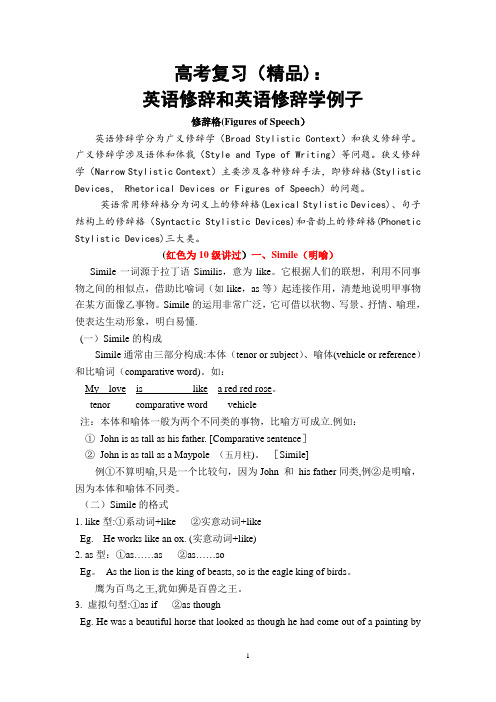
高考复习(精品):英语修辞和英语修辞学例子修辞格(Figures of Speech)英语修辞学分为广义修辞学(Broad Stylistic Context)和狭义修辞学。
广义修辞学涉及语体和体裁(Style and Type of Writing)等问题。
狭义修辞学(Narrow Stylistic Context)主要涉及各种修辞手法,即修辞格(Stylistic Devices, Rhetorical Devices or Figures of Speech)的问题。
英语常用修辞格分为词义上的修辞格(Lexical Stylistic Devices)、句子结构上的修辞格(Syntactic Stylistic Devices)和音韵上的修辞格(Phonetic Stylistic Devices)三大类。
(红色为10级讲过)一、Simile(明喻)Simile一词源于拉丁语Similis,意为like。
它根据人们的联想,利用不同事物之间的相似点,借助比喻词(如like,as等)起连接作用,清楚地说明甲事物在某方面像乙事物。
Simile的运用非常广泛,它可借以状物、写景、抒情、喻理,使表达生动形象,明白易懂.(一)Simile的构成Simile通常由三部分构成:本体(tenor or subject)、喻体(vehicle or reference)和比喻词(comparative word)。
如:My love is like a red red rose。
tenor comparative word vehicle注:本体和喻体一般为两个不同类的事物,比喻方可成立.例如:①John is as tall as his father. [Comparative sentence]②John is as tall as a Maypole (五月柱)。
[Simile]例①不算明喻,只是一个比较句,因为John 和his father同类,例②是明喻,因为本体和喻体不同类。
英语修辞整理及例子
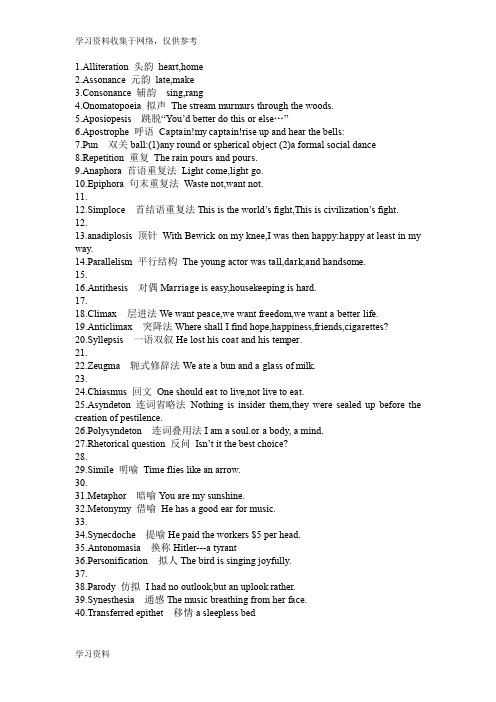
学习资料收集于网络,仅供参考1.Alliteration 头韵heart,home2.Assonance 元韵late,make3.Consonance 辅韵sing,rang4.Onomatopoeia 拟声The stream murmurs through the woods.5.Aposiopesis 跳脱“You’d better do this or else…”6.Apostrophe 呼语Captain!my captain!rise up and hear the bells:7.Pun 双关ball:(1)any round or spherical object (2)a formal social dance8.Repetition 重复The rain pours and pours.9.Anaphora 首语重复法Light come,light go.10.Epiphora 句末重复法Waste not,want not.11.12.Simploce首结语重复法This is the world’s fight,This is civilization’s fight.12.13.anadiplosis 顶针With Bewick on my knee,I was then happy:happy at least in my way.14.Parallelism 平行结构The young actor was tall,dark,and handsome.15.16.Antithesis 对偶Marriage is easy,housekeepin g is hard.17.18.Climax 层进法We want peace,we want freedom,we want a better life.19.Anticlimax 突降法Where shall I find hope,happiness,friends,cigarettes?20.Syllepsis 一语双叙He lost his coat and his temper.21.22.Zeugma 轭式修辞法We ate a bun and a glass of milk.23.24.Chiasmus 回文One should eat to live,not live to eat.25.Asyndeton 连词省略法Nothing is insider them,they were sealed up before the creation of pestilence.26.Polysyndeton 连词叠用法I am a soul.or a body, a mind.27.Rhetorical question 反问Isn’t it the best choice?28.29.Simile 明喻Time flies like an arrow.30.31.Metaphor 暗喻You are my sunshine.32.Metonymy 借喻He has a good ear for music.33.34.Synecdoche 提喻He paid the workers $5 per head.35.Antonomasia 换称Hitler---a tyrant36.Personification 拟人The bird is singing joyfully.37.38.Parody 仿拟I had no outlook,but an uplook rather.39.Synesthesia 通感The music breathing from her face.40.Transferred epithet 移情a sleepless bed学习资料。
英语修辞手法的例子

英语修辞手法的例子修辞手法是英语写作中常用的技巧,通过巧妙地运用修辞手法,可以使文章更加生动、有趣,增强表达的力度和说服力。
本文将为您介绍几个常见的英语修辞手法,并给出相应的例子。
1. 比喻(Metaphor)比喻是通过将两个不同的事物进行比较,以突出特点或者形成新的意义。
例如,“He is a shining star.”(他是一颗耀眼的星星)中的“shining star”用来形容一个人的光彩照人,突出其出众的品质。
2. 拟人(Personification)拟人是将非人事物赋予人的特质和行为。
例如,“The wind whispered throughthe trees.”(风从树上低语)中的“whispered”给风以说话的特征,使得文中的描述更加生动有趣。
3. 排比(Parallelism)排比是将一系列的词、短语或句子以相同的结构和形式排列,以增强语言的节奏和力度。
例如,“I came, I saw, I conquered.”(我来了,我看见了,我征服了)中的排比句结构使得句子的表达更加有力,同时也起到强调的作用。
4. 反问(Rhetorical Question)反问是用问句的形式来表达肯定或否定的意义,不需要回答。
例如,“Do you think I'm stupid?”(你以为我傻吗?)中的反问句用来表达说话者不以为然的态度,强调说话者的观点。
5. 倒装(Inversion)倒装是将句子中的主语和谓语的位置调换,以突出语句的重点或者增加语法的多样性。
例如,“Never have I seen such a beautiful sunset.”(我从未见过如此美丽的日落)中的倒装结构使得句子更加强调“我从未见过”的部分,增强了表达的效果。
6. 夸张(Hyperbole)夸张是通过对事物进行夸大的描述,以增强表达的效果和感染力。
例如,“I'm so hungry, I could eat a horse.”(我饿得可以吃一匹马)中的夸张手法用来强调说话者的饥饿程度,形象地表达了饥饿的感受。
英语修辞学例子
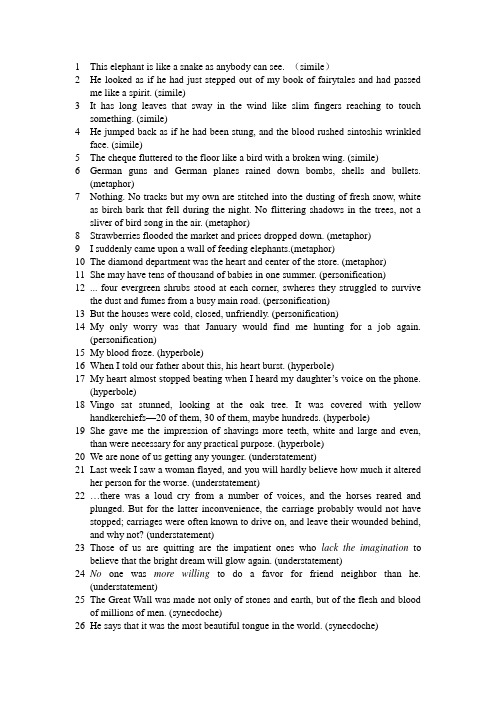
1This elephant is like a snake as anybody can see. (simile)2He looked as if he had just stepped out of my book of fairytales and had passed me like a spirit. (simile)3It has long leaves that sway in the wind like slim fingers reaching to touch something. (simile)4He jumped back as if he had been stung, and the blood rushed sintoshis wrinkled face. (simile)5The cheque fluttered to the floor like a bird with a broken wing. (simile)6German guns and German planes rained down bombs, shells and bullets.(metaphor)7Nothing. No tracks but my own are stitched into the dusting of fresh snow, white as birch bark that fell during the night. No flittering shadows in the trees, not a sliver of bird song in the air. (metaphor)8Strawberries flooded the market and prices dropped down. (metaphor)9I suddenly came upon a wall of feeding elephants.(metaphor)10The diamond department was the heart and center of the store. (metaphor)11She may have tens of thousand of babies in one summer. (personification) 12... four evergreen shrubs stood at each corner, swheres they struggled to survivethe dust and fumes from a busy main road. (personification)13But the houses were cold, closed, unfriendly. (personification)14My only worry was that January would find me hunting for a job again.(personification)15My blood froze. (hyperbole)16When I told our father about this, his heart burst. (hyperbole)17My heart almost stopped beating when I heard my daughter’s voice on the phone.(hyperbole)18Vingo sat stunned, looking at the oak tree. It was covered with yellow handkerchiefs—20 of them, 30 of them, maybe hundreds. (hyperbole)19She gave me the impression of shavings more teeth, white and large and even, than were necessary for any practical purpose. (hyperbole)20We are none of us getting any younger. (understatement)21Last week I saw a woman flayed, and you will hardly believe how much it altered her person for the worse. (understatement)22…there was a loud cry from a number of voices, and the horses reared and plunged. But for the latter inconvenience, the carriage probably would not have stopped; carriages were often known to drive on, and leave their wounded behind, and why not? (understatement)23Those of us are quitting are the impatient ones who lack the imagination to believe that the bright dream will glow again. (understatement)24No one was more willing to do a favor for friend neighbor than he.(understatement)25The Great Wall was made not only of stones and earth, but of the flesh and blood of millions of men. (synecdoche)26He says that it was the most beautiful tongue in the world. (synecdoche)27Many eyes turned to a tall,20—year black girl on the U.S. team. (synecdoche)28Several years later, word came that Napoleonyh himself was coming to inspect them. (metonymy)29Al spoke with his eyes,“yes”. (metonymy)30So, during any five-week shape-up, focus more on the tape measure than on the bathroom scale. (metonymy)31Against the Oval Earth man, the first card I can play is the analogy of the sun and moon. (metonymy)32Senior citizens are respected in our country. (euphemism)33There are several pensioners in my school. (euphemism)34He has difficulty distinguishing between imaginary and factual information.(euphemism)35He needs help in learning to adhere to rules and standards of fair play.(euphemism)36Palestinian militants in the Gaza Strip bombarded the western Negev with dozens of Qassam rockets and mortar shells on Wednesday, burdening diplomatic efforts to revive a truce that expired over the weekend. (euphemism)37Rushing thongs, blinded by the darkness and smoke, rushed up on a street and down the next trampling the fallen in a crazy fruitless dash toward safety.(transferred epithet)38Sometimes they threw (him) bits of food, and got scant thanks; sometimes a mischievous pebble, and a shower of stones and abuses. (transferred epithet)39And the first tender singing of the passionate throat of a young collier, who has since drunk himself to death. (transferred epithet)40I suggest too that you avoid the big swamp in the southeast corner of the island.We call it Death Swamp. (transferred epithet)41Of the thousands of people who stand under Michelangelo’s heroic ceiling in the Sistine Chapel, very few are aware that they are looking a perhaps the greatest watercolor painting in the world. (transferred epithet)42It must be created by the blood and the work of all of us who believe in the future, who believe in man and his glorious man—made destiny. (parallelism)43... Because good technique in medicine and surgery means more quickly—curedpatients, less pain, less discomfort, less death, less disease and less deformity.(parallelism)44Napoleon was astonished. “Either you are mad, or I am,” He declared. “Both,sir!”cried the Swede proudly. (pun)45First gentleman: Thou art always figuring disease in me, but thou art full of error,I am sound. Lucio: Nay, not as one would say, healthy; but so sound as things thatare hollow; impiety has made a feast of thee. (pun)46Some books are to be tasted, others to be swallowed and some few to be chewed and digested. (synesthesia)07级英教(3)班常婷12007243601。
- 1、下载文档前请自行甄别文档内容的完整性,平台不提供额外的编辑、内容补充、找答案等附加服务。
- 2、"仅部分预览"的文档,不可在线预览部分如存在完整性等问题,可反馈申请退款(可完整预览的文档不适用该条件!)。
- 3、如文档侵犯您的权益,请联系客服反馈,我们会尽快为您处理(人工客服工作时间:9:00-18:30)。
1This elephant is like a snake as anybody can see. (simile)2He looked as if he had just stepped out of my book of fairytales and had passed me like a spirit. (simile)3It has long leaves that sway in the wind like slim fingers reaching to touch something. (simile)4He jumped back as if he had been stung, and the blood rushed sintoshis wrinkled face. (simile)5The cheque fluttered to the floor like a bird with a broken wing. (simile)6German guns and German planes rained down bombs, shells and bullets.(metaphor)7Nothing. No tracks but my own are stitched into the dusting of fresh snow, white as birch bark that fell during the night. No flittering shadows in the trees, not a sliver of bird song in the air. (metaphor)8Strawberries flooded the market and prices dropped down. (metaphor)9I suddenly came upon a wall of feeding elephants.(metaphor)10The diamond department was the heart and center of the store. (metaphor)11She may have tens of thousand of babies in one summer. (personification) 12... four evergreen shrubs stood at each corner, swheres they struggled to survivethe dust and fumes from a busy main road. (personification)13But the houses were cold, closed, unfriendly. (personification)14My only worry was that January would find me hunting for a job again.(personification)15My blood froze. (hyperbole)16When I told our father about this, his heart burst. (hyperbole)17My heart almost stopped beating when I heard my daughter’s voice on the phone.(hyperbole)18Vingo sat stunned, looking at the oak tree. It was covered with yellow handkerchiefs—20 of them, 30 of them, maybe hundreds. (hyperbole)19She gave me the impression of shavings more teeth, white and large and even, than were necessary for any practical purpose. (hyperbole)20We are none of us getting any younger. (understatement)21Last week I saw a woman flayed, and you will hardly believe how much it altered her person for the worse. (understatement)22…there was a loud cry from a number of voices, and the horses reared and plunged. But for the latter inconvenience, the carriage probably would not have stopped; carriages were often known to drive on, and leave their wounded behind, and why not? (understatement)23Those of us are quitting are the impatient ones who lack the imagination to believe that the bright dream will glow again. (understatement)24No one was more willing to do a favor for friend neighbor than he.(understatement)25The Great Wall was made not only of stones and earth, but of the flesh and blood of millions of men. (synecdoche)26He says that it was the most beautiful tongue in the world. (synecdoche)27Many eyes turned to a tall,20—year black girl on the U.S. team. (synecdoche)28Several years later, word came that Napoleonyh himself was coming to inspect them. (metonymy)29Al spoke with his eyes,“yes”. (metonymy)30So, during any five-week shape-up, focus more on the tape measure than on the bathroom scale. (metonymy)31Against the Oval Earth man, the first card I can play is the analogy of the sun and moon. (metonymy)32Senior citizens are respected in our country. (euphemism)33There are several pensioners in my school. (euphemism)34He has difficulty distinguishing between imaginary and factual information.(euphemism)35He needs help in learning to adhere to rules and standards of fair play.(euphemism)36Palestinian militants in the Gaza Strip bombarded the western Negev with dozens of Qassam rockets and mortar shells on Wednesday, burdening diplomatic efforts to revive a truce that expired over the weekend. (euphemism)37Rushing thongs, blinded by the darkness and smoke, rushed up on a street and down the next trampling the fallen in a crazy fruitless dash toward safety.(transferred epithet)38Sometimes they threw (him) bits of food, and got scant thanks; sometimes a mischievous pebble, and a shower of stones and abuses. (transferred epithet)39And the first tender singing of the passionate throat of a young collier, who has since drunk himself to death. (transferred epithet)40I suggest too that you avoid the big swamp in the southeast corner of the island.We call it Death Swamp. (transferred epithet)41Of the thousands of people who stand under Michelangelo’s heroic ceiling in the Sistine Chapel, very few are aware that they are looking a perhaps the greatest watercolor painting in the world. (transferred epithet)42It must be created by the blood and the work of all of us who believe in the future, who believe in man and his glorious man—made destiny. (parallelism)43... Because good technique in medicine and surgery means more quickly—curedpatients, less pain, less discomfort, less death, less disease and less deformity.(parallelism)44Napoleon was astonished. “Either you are mad, or I am,” He declared. “Both,sir!”cried the Swede proudly. (pun)45First gentleman: Thou art always figuring disease in me, but thou art full of error,I am sound. Lucio: Nay, not as one would say, healthy; but so sound as things thatare hollow; impiety has made a feast of thee. (pun)46Some books are to be tasted, others to be swallowed and some few to be chewed and digested. (synesthesia)07级英教(3)班常婷12007243601。
